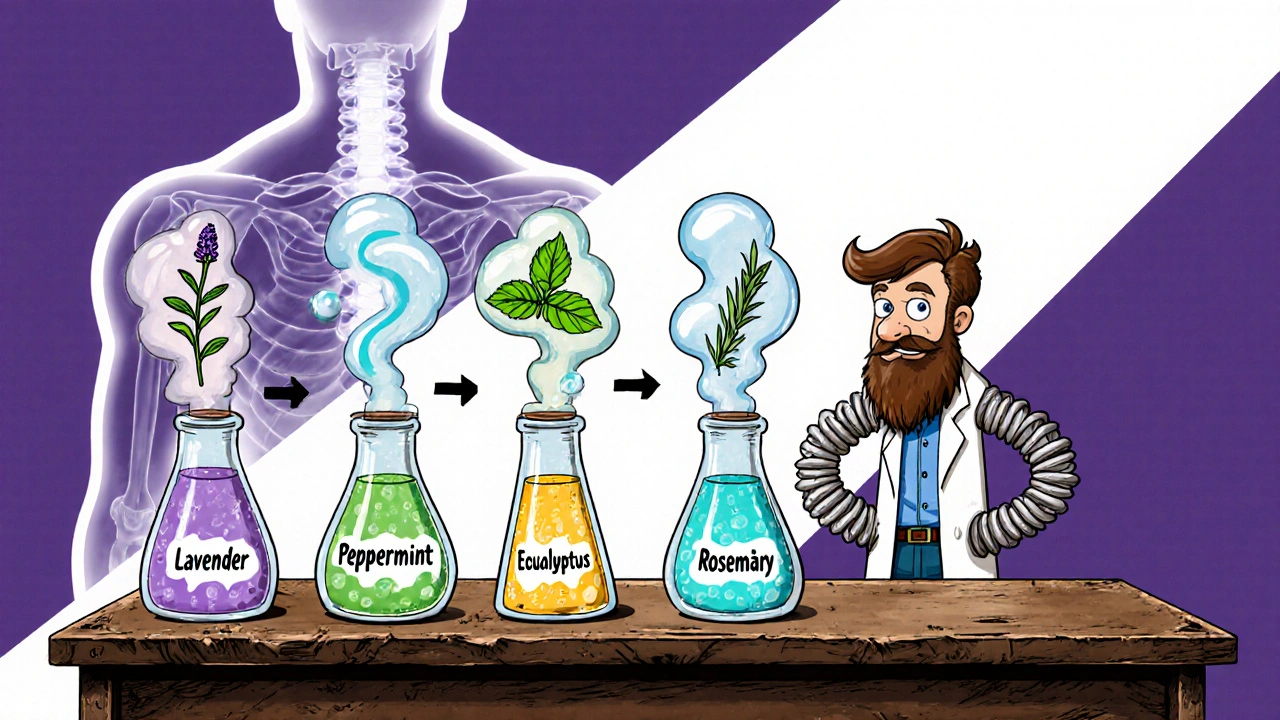
Essential Oil Dilution Calculator
Safe Dilution Calculator for Back Pain Relief
Calculate precise essential oil ratios for topical application based on carrier oil volume. Follow safety guidelines from the article.
Back pain can turn a simple day into a marathon of discomfort, and many people reach for pills that only mask the ache. Aromatherapy is a practice of using volatile plant extracts, known as essential oils, to promote physical and emotional well‑being, and it offers a drug‑free way to soothe sore muscles, calm nerves, and improve circulation. If you’ve ever wondered whether a few drops of lavender or peppermint could actually ease that nagging throb, this guide breaks down the science, the best oils, and step‑by‑step methods to make aromatherapy work for your back.
Key Takeaways
- Aromatherapy reduces inflammation and muscle tension, two major contributors to back pain.
- Lavender, peppermint, eucalyptus, and rosemary are the most researched oils for back‑ache relief.
- Topical dilution (usually 2‑5% essential oil in a carrier) is safe and effective for most adults.
- Combine inhalation, massage, and heat therapy for a synergistic pain‑relief routine.
- People with pregnancy, epilepsy, or severe skin conditions should consult a health professional before use.
How Aromatherapy Works for Back Pain
Essential oils contain complex chemical compounds that interact with the body in three main ways:
- Anti‑inflammatory action: Molecules like linalool (found in lavender) and menthol (in peppermint) inhibit cytokine production, which helps reduce swelling around irritated nerves.
- Analgesic signaling: Certain terpenes bind to TRPV1 receptors, the same channels that perceive heat and pain, providing a mild numbing effect.
- Neurological calming: Citrus scents and floral notes can lower cortisol levels, easing the stress‑induced muscle tightening that often worsens back discomfort.
When these actions are combined with gentle massage or warm compresses, the result is improved blood flow, faster tissue repair, and a noticeable drop in perceived pain.
Best Essential Oils for Backache Relief
Not all oils are created equal. Below is a quick rundown of the most effective options, including their key active components and typical applications.
| Oil | Main Active Component | Pain‑Relief Mode | Recommended Use |
|---|---|---|---|
| Lavender (Lavandula angustifolia) | Linalool, Linalyl acetate | Anti‑inflammatory, muscle relaxation | Massage blend, diffused before bedtime |
| Peppermint (Mentha piperita) | Menthol, menthone | Cooling analgesic, nerve desensitization | Cold compress with carrier oil, post‑exercise |
| Eucalyptus (Eucalyptus radiata) | 1,8‑cineole | Anti‑inflammatory, respiratory aid | Steam inhalation, massage for deep tissue |
| Rosemary (Rosmarinus officinalis) | Camphor, rosmarinic acid | Stimulates circulation, reduces muscle spasm | Warm oil rub, combined with ginger |
Each oil can be used alone, but many find that a blend-say, lavender plus peppermint-covers both soothing and cooling needs, tackling inflammation and nerve irritation simultaneously.

Safe Application Methods
Topical use is the most direct way to target a sore spot, but it must be diluted to avoid skin irritation. Follow these basic guidelines:
- Carrier oils: Sweet almond, jojoba, or fractionated coconut work well because they’re hypoallergenic and absorb slowly.
- Dilution ratios: 2% for daily use (10drops essential oil per 30ml carrier) and up to 5% for acute flare‑ups (15drops per 30ml).
- Patch test: Apply a tiny dab of the diluted blend to the inner forearm and wait 15 minutes. No redness or itching? You’re good to go.
- Massage technique: Use gentle, circular motions for 5‑10minutes, moving from the lower back up toward the shoulders. This promotes lymphatic drainage and helps the oil penetrate deeper.
If you prefer inhalation, a few drops in a diffuser or a personal inhaler can calm the nervous system before bedtime, reducing the muscle tension that often wakes you up at night.
DIY Aromatherapy Blends for Back Pain
Creating your own blend lets you fine‑tune the scent and potency. Below are two tested recipes:
Cooling Relief Blend
- 10ml fractionated coconut oil (carrier)
- 6drops peppermint oil
- 4drops eucalyptus oil
- 2drops lavender oil
Shake well, store in a dark glass bottle, and apply to the sore area after a warm shower. The cooling menthol meets the anti‑inflammatory linalool for quick soothing.
Warm Comfort Blend
- 12ml sweet almond oil
- 5drops rosemary oil
- 5drops lavender oil
- 2 drops ginger essential oil (optional for extra heat)
Heat the mixture briefly in a water‑bath (not microwave) before massaging. The heat enhances circulation while the rosemary stimulates tissue repair.

Integrating Aromatherapy into Your Daily Routine
Consistency beats occasional use. Here’s a simple schedule you can adopt:
- Morning: Diffuse 3drops lavender for 15minutes while you stretch or do gentle yoga.
- Mid‑day: Apply the cooling blend to the lower back after lunch, especially if you’ve been sitting for hours.
- Evening: Massage the warm comfort blend into the shoulders and upper back before bed; follow with a 5‑minute deep‑breathing session.
Even on days when pain is mild, the routine helps keep inflammation low and prevents flare‑ups.
Potential Risks and Contra‑indications
While aromatherapy is generally safe, a few cautions are worth noting:
- Pregnancy: Avoid high‑dose peppermint and rosemary; they can stimulate uterine activity.
- Epilepsy: Certain strong citrus or eucalyptus scents may trigger seizures in susceptible individuals.
- Skin conditions: If you have eczema or psoriasis, do a thorough patch test and stick to low (1‑2%) dilutions.
- Medication interactions: Oils like rosemary can influence blood‑thinning drugs; consult your physician if you’re on anticoagulants.
When in doubt, start with a single drop of a mild oil (like lavender) in a large carrier amount and observe how your body responds.
Frequently Asked Questions
Can I use aromatherapy instead of pain medication?
Aromatherapy can lower the need for occasional over‑the‑counter painkillers, but it isn’t a complete substitute for chronic conditions that require medical supervision. Use it as a complementary approach alongside prescribed treatments.
How long does a single aromatherapy session last?
A 10‑15minute massage or a 30‑minute diffusion session is enough to trigger the anti‑inflammatory cascade. Repeat 2‑3 times per day during a flare‑up.
Do I need a diffuser for the best results?
A diffuser boosts the inhalation route, which calms the nervous system. However, topical application delivers the active compounds directly to the muscles, so you can skip a diffuser if you focus on massage.
Is there an age limit for using essential oils?
Children under 3 should avoid strong oils altogether. For kids 4‑12, use very low dilutions (0.5‑1%) and stick to gentle scents like lavender or chamomile.
Can I combine aromatherapy with heat packs?
Yes. Apply a diluted oil blend first, then cover the area with a warm (not hot) pack for 10‑15minutes. The heat improves skin permeability and deepens the oil’s effect.

Christopher Ellis
October 16, 2025 AT 18:02We tend to think scent is just a pleasant afterthought but in fact the olfactory system taps into the limbic brain which governs pain perception, so the whole "aroma = flavor" myth is naive and limits our view of aromatherapy
kathy v
October 21, 2025 AT 00:40Listen up fellow Americans this isn’t just some hippie fad the left pushes, it’s a proven tactical advantage for anyone who wants to keep their back in fighting shape. The science behind lavender and peppermint is solid and the government should fund more research instead of banning essential oils in schools. If you’re still skeptical, remember that our founding fathers relied on natural remedies, not synthetic pills. The civic duty of each citizen is to explore these homegrown solutions and not be swayed by big pharma propaganda. In short – grab a bottle, dilute it, and protect your spine while you protect our nation’s freedom.
Daryl Foran
October 25, 2025 AT 04:40Honestly the whole "essential oils cure everything" hype is overblown you cant just dump a few drops and expect miracles it just numbs a bit but doesn't fix underlying issues
Michael Dion
October 29, 2025 AT 07:40Sounds like a decent add‑on.
Trina Smith
November 2, 2025 AT 11:40From a philosophical perspective, the act of caring for one's body through scent aligns with the ancient principle of harmony between mind and flesh. The ritual of mixing carrier oils, the gentle touch of massage – each step is a meditation on self‑compassion. 🌿 This embodies a cultural tradition of holistic health that transcends modern medical compartmentalization.
Jacob Smith
November 6, 2025 AT 15:40Yo! If you're looking for a quick win, try the cooling blend after a workout – just mix the oils, rub it in, and feel that fresh burst. Trust me, you'll notice less tightness. Keep it consistent and you'll be back to crushing it in no time!
Chris Atchot
November 10, 2025 AT 19:40Great points! However, I’d like to add that when diluting, one should always adhere to the 2% rule for daily use-i.e., ten drops of essential oil per 30 ml of carrier. This ensures safety while maximizing efficacy; moreover, a patch test is absolutely essential before full application.
katie clark
November 14, 2025 AT 23:40While the layperson may find solace in these aromatics, true connoisseurs recognize the nuanced interplay of terpenes that underpins any legitimate analgesic effect.
Julie Gray
November 19, 2025 AT 03:40It ought to be noted, with the utmost formality, that certain manufacturers have been implicated in clandestine operations to obfuscate the provenance of their essential oils, thereby compromising the integrity of any purported therapeutic outcomes.
Lisa Emilie Ness
November 23, 2025 AT 07:40Thanks for the reminder to stay within safe dilution thresholds.
Emily Wagner
November 27, 2025 AT 11:40Yo folks this stuff is legit the oils have the chemicals that hit pain receptors like a boss you just gotta mix ‘em right and you’re golden.
Mark French
December 1, 2025 AT 15:40Dear Reader, I extend my sincere appreciation for your diligent consideration of these practices. May your endeavors in aromatherapy be both safe and beneficial, fostering relief and wellbeing.
Daylon Knight
December 5, 2025 AT 19:40Oh sure, because a few drops of peppermint are going to solve all the structural issues in your spine – next you’ll be telling us to replace physiotherapy with scented candles.
Jason Layne
December 9, 2025 AT 23:40One must question the hidden agendas behind the promotion of these aromatic concoctions, for every “natural” solution presented to the public is often a veil for deeper, more insidious control mechanisms embedded within pharmaceutical conspiracies.
Hannah Seo
December 14, 2025 AT 03:40When incorporating aromatherapy into a back‑pain regimen, it is essential to follow a comprehensive, evidence‑based protocol that addresses both the physiological and psychosocial components of chronic discomfort. First, conduct a thorough assessment of the individual's medical history, including any contraindications such as pregnancy, epilepsy, or dermatological sensitivities, to ensure safety. Next, select appropriate essential oils-lavender for its anti‑inflammatory properties, peppermint for its cooling analgesic effect, eucalyptus for respiratory support, and rosemary for enhanced circulation. Dilute these oils to a 2 % concentration for routine use, employing carrier oils like sweet almond, jojoba, or fractionated coconut to facilitate transdermal absorption while minimizing irritation. Perform a patch test on a small area of skin, waiting fifteen minutes to confirm the absence of adverse reactions. For topical application, employ a gentle massage technique: use circular motions for five to ten minutes, progressing from the lumbar region upward toward the scapulae, thereby promoting lymphatic drainage and deeper penetration of the active constituents.
In addition to massage, integrate inhalation therapy by diffusing a modest amount (three to five drops) of lavender or a blend of peppermint and eucalyptus for fifteen minutes during morning stretching routines. This dual approach leverages both peripheral and central pathways to modulate pain perception, reducing cortisol levels and fostering muscular relaxation. Consistency is paramount; a structured schedule-morning diffusion, midday topical cooling blend, and evening warm comfort blend-optimizes therapeutic outcomes and curtails flare‑ups.
Furthermore, educate patients on adjunctive lifestyle modifications: maintain ergonomic postures, incorporate regular low‑impact aerobic activity, and ensure adequate hydration, as systemic inflammation can exacerbate musculoskeletal pain. Encourage ongoing communication with healthcare providers to monitor progress and adjust the aromatherapy protocol as needed, particularly when integrating with conventional pharmacologic treatments.
Finally, document outcomes systematically, noting changes in pain intensity, functional mobility, and quality of life metrics. This data-driven approach not only validates the efficacy of essential oils within a multimodal pain management plan but also contributes to the broader scientific discourse on integrative therapies.
By adhering to these guidelines, practitioners can responsibly harness the therapeutic potential of aromatherapy, offering patients a complementary avenue for back‑pain relief that is both safe and grounded in current research.